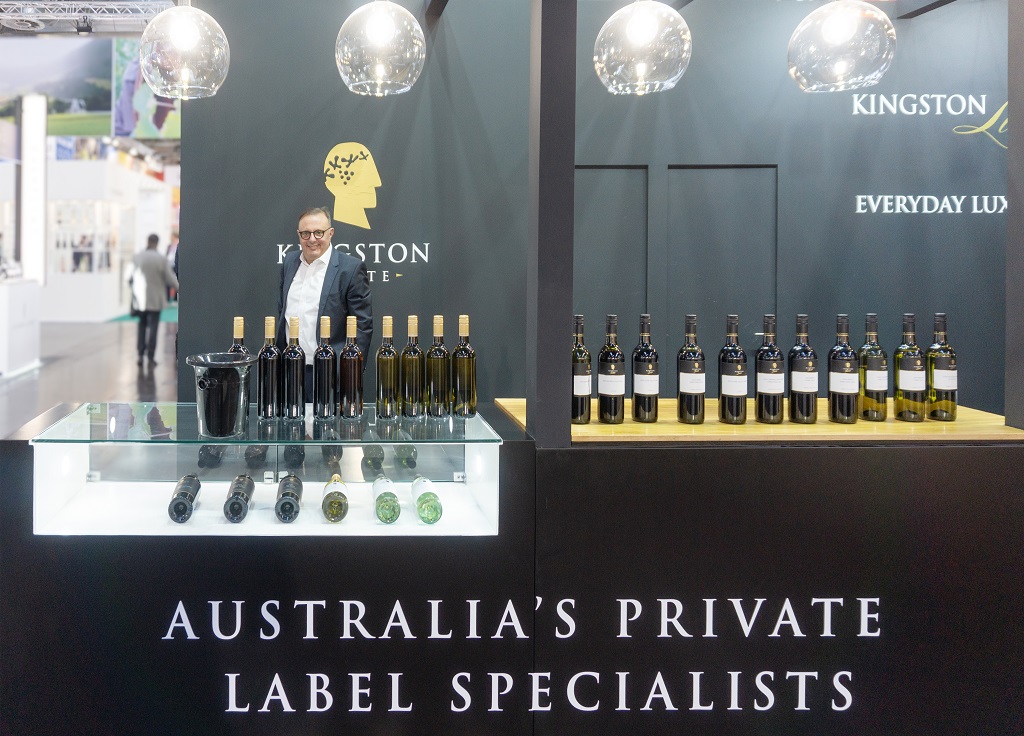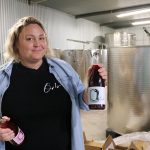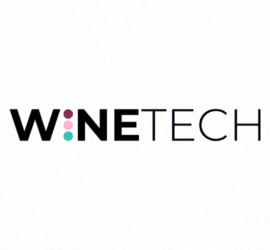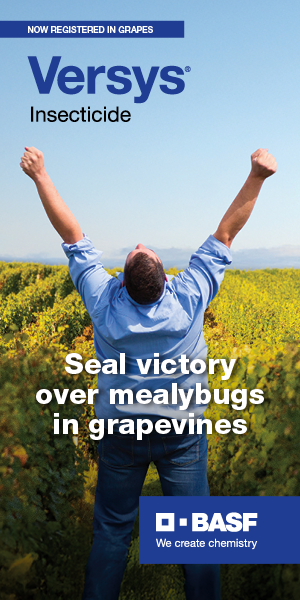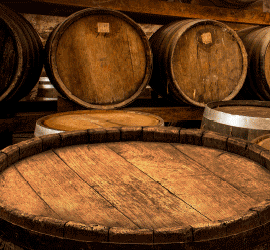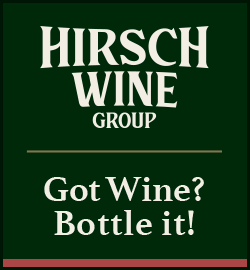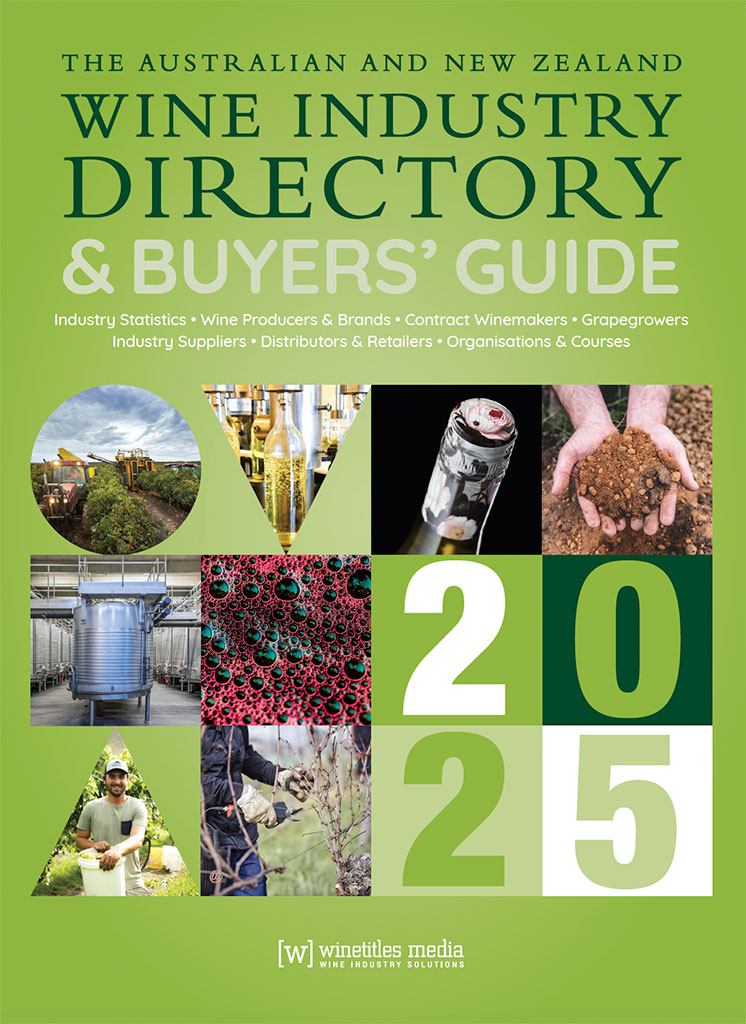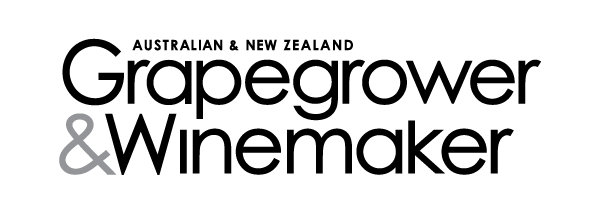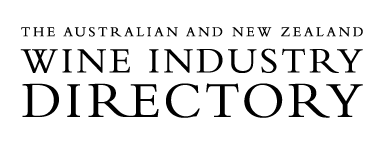Bill Moularadellis at Kingston Estate’s ProWein stand in Düsseldorf
Journalist Meg Riley recently travelled to Germany to attend ProWein Düsseldorf. There, she spoke to producers on the ground about how they utilise the global market meeting place for business, the positives of presenting a united front, how to strengthen the position of Australian and New Zealand wines, and their fears of missing out.
With Wine Australia absent from the event, Australian producers at the fair lacked an ‘Australia’ banner grouping them together, prompting discussion amongst producers around how Australian wines were presented and perceived on a global stage, and whether leading solely with small and premium producers was a solid strategy for the country. New Zealand producers, who were joined by New Zealand Winegrowers, subsequently outnumbered the Australian stands, although numerous Kiwi producers also believed their stalls would benefit from the presence of a representative body for Australian Wine.
For some South Australian producers, the perception of Australian wine in the current economic climate was of paramount importance.
Bill Moularadellis, managing director of Kingston Estate in the Riverland, said that it was “disappointing” that Wine Australia could not attend the event.
“This has traditionally been a location that we just meet with all of our international customers,” Moularadellis explained. “It’s preferable that we have a banner that we all congregate under, and I would hope that Wine Australia could find the resources to do both Wine Paris and this fair, because they are both very important.”
Moularadellis said that with businesses still adjusting to the global reduction in consumption, it was a crucial time to set the path forward.
“I think the winners will be those countries and companies that can pivot to the new paradigm, and Australia has a real opportunity to be part of that regeneration,” he said.
“I’m not sure that we currently have the mindset to do that, but certainly there is a very clear pathway that Australia can re-invigorate the wine category and more effectively make products for the new and emerging consumer.
“One of the biggest challenges that we have is [that] our wine culture is one that is generally about premiumisation and making fine wine, but we do have to be mindful that to able to be successful in the fine wine category, we need to have a quality ladder that allows us to engage with new and emerging consumers, and allow them to move up the quality ladder towards those premium wines.”
This quality ladder, as Moularadellis refers to it, is something which he sees as essential in engaging these new consumers to the wine category. As his argument highlights, the type of wines needed to engage new consumers and the wines that fall under the ‘premiumisation’ trend that everyone is currently heralding, may well fall at opposite ends of this ladder.
“I think criticism of Australia has been that we’ve forgotten that need to engage new and emerging consumers,” said Moularadellis.
Moularadellis added the attitude of buyers and visitors at the ProWein fair was “fantastic”.
“Everybody is looking for ways to engage, and it’s disappointing that we [are] continually looking at it from a glass half empty [perspective]—the glass is half full, and it’s up to us to continually innovate and provide products that take command of the consumer narrative.
“I’m optimistic,” he added, “and I’m confident that Australia can be the country that leads the charge […] with new products that connect with the new consumer.”
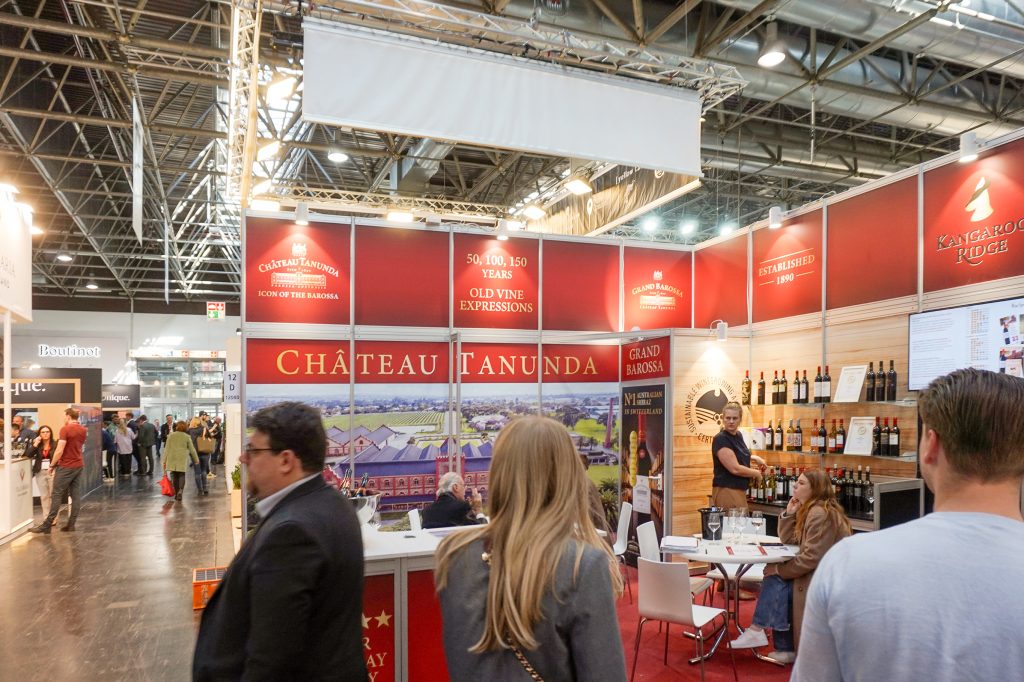
Managing director at Château Tanunda in the Barossa, Michelle Geber was equally concerned about emphasising the historical side of the Australian wine story, and was particularly eager to do so whilst shoulder-to-shoulder with rival French and Italian producers.
“It’s really important for us to tell the old vine story of the Barossa,” she said. “We have wines from vines that are 35 years and older, 50 years and older, 100 years and older, and also 150 years and older. These vines are older than a lot of the vines in Europe. So it’s quite interesting, because there’s always a little bit of competition between what is the ‘Old World’ and what is the ‘New World’ and who makes the most fantastic luxury wines, and so we do, in the Barossa, have some of the greatest varieties of old vine wines in the world on original European rootstocks.”
One of the standout benefits of attending ProWein Düsseldorf, Geber explained, is the opportunity for brand building.
“Brand-building not only for your individual winery, or your region, but also for the country,” she elaborated.
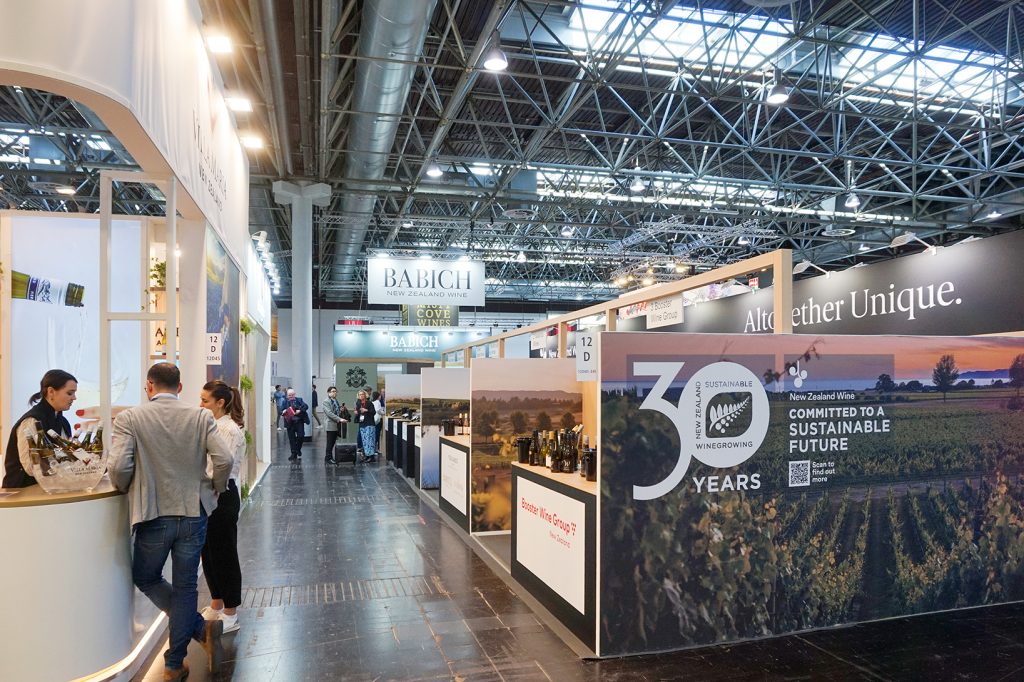
For our friends across the ditch, there was a ‘New Zealand’ banner under which many smaller producers were exhibiting, opting to participate in the New Zealand Winegrowers’ stand in lieu of having to fork out for a large stand of their own.
“We love being part of the New Zealand Winegrowers collective,” explained Wendy Trolove, business development and communications manager Ant Moore Wines in Marlborough.
“It fits really well for us: we get to meet our colleagues at the same time, but it kind of brings New Zealand together—we are small in terms of our production—yes, Sauvignon Blanc’s everywhere in the world, but we are still the little guys. So that’s a really nice aspect of it as well: that we get to [present] a united front for New Zealand wines.”
The advantage of unity was something which Trolove considered to extend beyond just New Zealanders supporting each other—noting that the benefits also applied to presenting alongside Australian wine.
Ant Moore Wines participated in the Australia and New Zealand Trade Tasting held by Wine Australia and New Zealand Winegrowers in the United Kingdom earlier this year, which Trolove was enthusiastic about.
“I think that is a really positive thing where we’ve got good synergies,” she said. “We don’t really compete too much in terms of varieties that we offer, either. And we’re pretty similar in the way we would do business as well.”
Balancing act
With the contraction in the wine industry affecting all areas of the sector, Wine Australia explained that its decision not to attend ProWein in 2025 was reached based on producer feedback, with the view to attend only either ProWein Düsseldorf or Wine Paris, not both.
“After ProWein 2024, Wine Australia contacted Australian states, regions and wineries about taking a booth on our stand at ProWein 2025,” said Paul Turale, general manager marketing, Wine Australia. “There was very limited appetite for ProWein and significant demand for Wine Paris.
“The feedback from wineries on our stand at Wine Paris was very positive, and most wineries that exhibited with us this year have already committed to 2026. We have been in touch with Vinexpo to increase our footprint at next year’s fair and it is likely that our presence will double from this year.
Wine Australia said it had provided feedback directly to ProWein organisers Messe Düsseldorf on what it perceived as the shortcomings—noting that many were factors outside of the organiser’s control and added that it welcomes their efforts to rectify these issues where practical.
“We work closely with ProWein in other locations but ultimately, limited resources will be prioritised to reflect the demand of our exhibitors,” said Turale.
A number of the Australian producers at ProWein Düsseldorf this year said they were not consulted by Wine Australia as to whether the representative body should have a presence at this fair, despite some of them having been on the Wine Australia stand at Wine Paris in February.
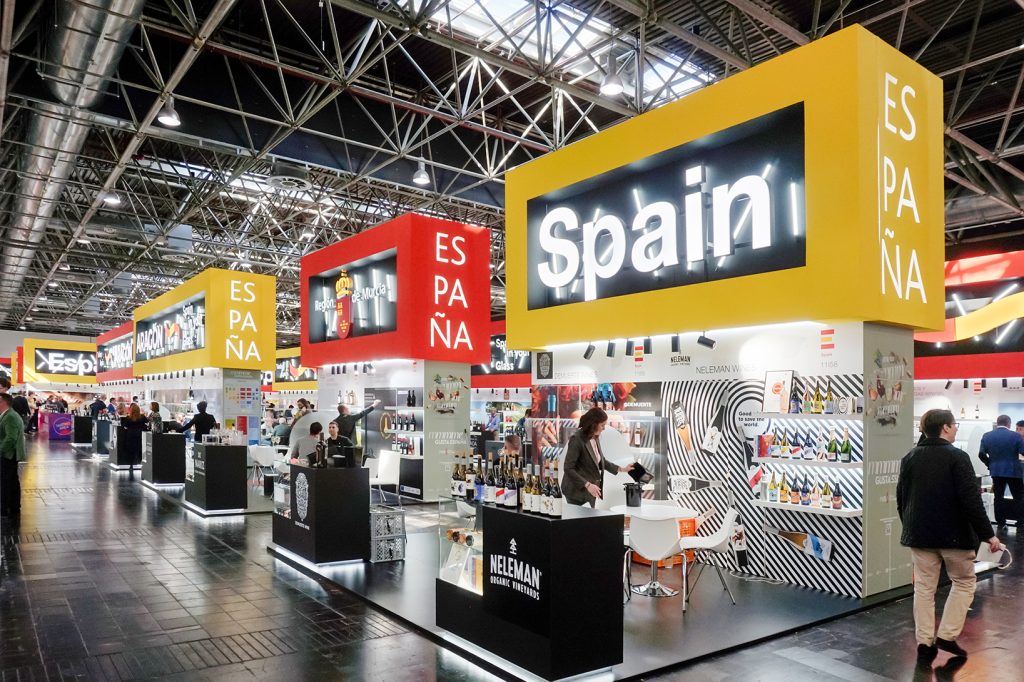
Quality over quantity
Competition is nothing new for anyone operating in the wine industry right now. Not shy of discussing ProWein’s competitor, Wine Paris, ProWein’s director Peter Schmitz explained why he sees this competition as a good thing.
“Competition helps us to have creativity, and new ideas for the future,” he said.
“We have to concentrate on our strengths. And our strengths are definitely the internationality of the ProWein show. We have exhibitors from 65 countries here, visitors from 130 countries here.”
“And yes, we are shrinking a bit, but that makes it, I think, easier for us, getting in the second row after Wine Paris, to concentrate on what we will do, the strategy for the future. To hold, or to get back the key players on the exhibitor side and also on the on the visitor side.”
Wine Australia’s absence from the fair was felt by more than just the exhibitors themselves—Schmitz explained that it affected the number of Australian wine exhibitors in attendance, but he added that the fair will work to win them back.

The focus for this year’s iteration of ProWein was quality, said Schmitz. Quality visitors, quality exhibitors, and a quality experience.
To hone concentration on this quality experience, a number of new initiatives were introduced, such as the business forum, where panels of expert speakers dissected pressing industry matters from information on improving sales and business development to understanding AI.
Schmitz said that the upset within the wine world was all the more reason to be connecting with the trade in-person, to gain new customers and solidify relationships with existing buyers.
“Tell me what is better than a trade show for this special industry, especially in times like these,” he said.
Looking at Wine Paris, Schmitz could see the familiar trappings of a fast expansion.
“Honestly, I think they are [making] the same mistake we did in the past—we grew too much. In 2019 we had around 6,900 exhibitors. But on the other hand, the number of trade visitors—you can’t reach a better level than around 50,000. But when you have 6,000 or 7,000 exhibitors, it makes it not easy.”
Now a well-oiled machine, ProWein 2025 focused on ironing out any remaining kinks in the cloth, such as previous complaints about its hotel shortcomings.
“We are working together for the first time with a platform called Kuoni Tumlare,” said Schmitz. “It’s a Swiss [company], like Booking.com. And they have several contingents for us with better prices in the city of Düsseldorf, but also a bit around […] cities like Essen, Duisburg, and that helps us.”
Business buzz
For Tim Abraham, EU sales and marketing manager for Australian producer Qualia Wines, the reduced numbers at ProWein were not necessarily a negative.
“What we like about it now is, in the old days, when ProWein was huge, it was uncomfortable,” he said. “There was too many people. You had to queue for an hour to get a taxi. You couldn’t get on the trams, you couldn’t get in the restaurants. It was a nightmare.
“Now, you’ve got less people, and it’s so much more comfortable. You just walk out, you get in the taxi, you go back to your hotel. You can walk into a restaurant, and they’ve got spare tables. We don’t need lots of visitors, we just need key, crucial buyers and all the—what we call ‘tire kickers’—they can go somewhere else.”
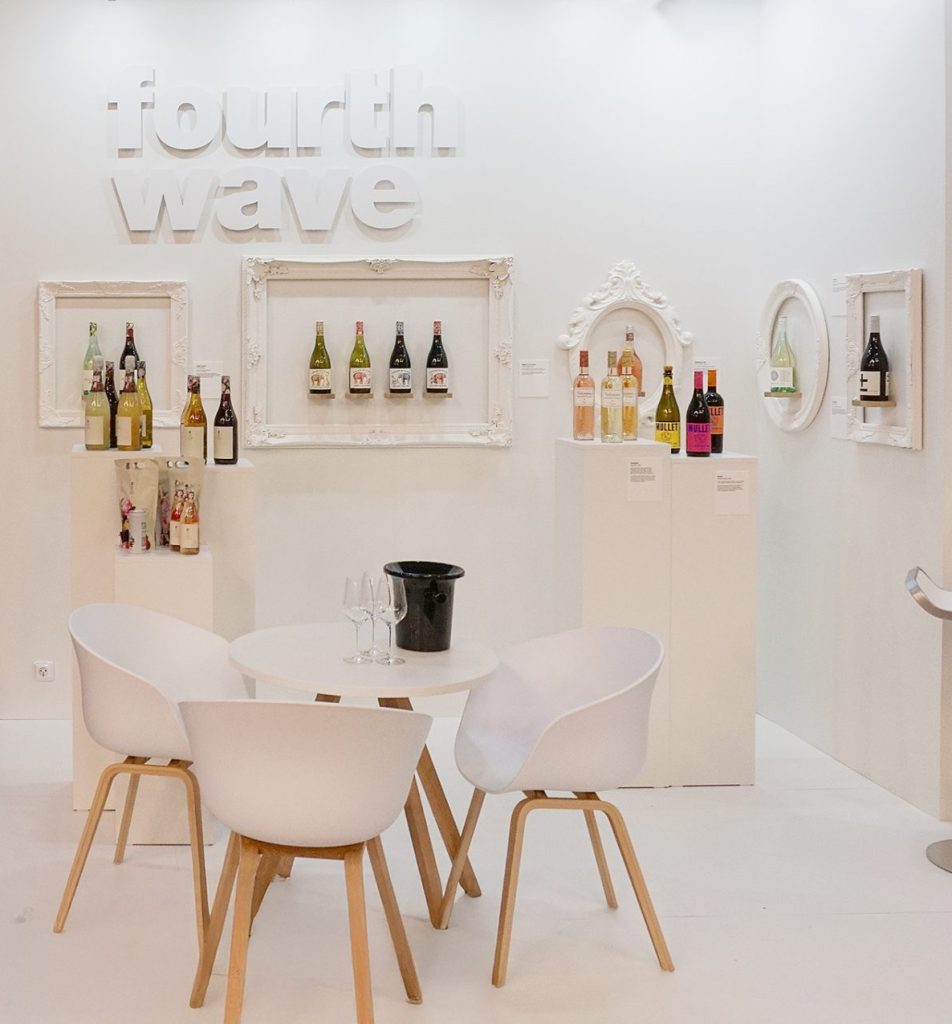
Australian winemaker Fourth Wave Wine also had a stand at Wine Paris, and co-owner Nicholas Crampton explained that although “pretty much all the major UK buyers” attended Wine Paris, a small number of quality visitors was all it took for a successful exhibition.
“Because we’re more of a large retail focus, one meeting, two meetings that are good—that’s worth the show,” he said.
Many producers emphasised the importance of scheduling ahead for a good show, regardless of the expected foot traffic.
“The pre-work is so important, and then, of course, keeping a bit of space and opportunity open to meet people at the fair as well, maybe some new leads,” said Geber.
Moularadellis echoed this attitude, explaining that all the bookings are arranged ahead of time.
“[ProWein] is just a convenient meeting place for existing arrangements. This year, many of the buyers have not come. And so it hasn’t been as busy as perhaps in other years, but all the important arrangements [are here].”
With the trade fair doubling as a global meeting place to catch up with existing buyers, Siobhan Wilson, general manager of sales and marketing at New Zealand winery Marisco, the event provided an opportunity to show off the winery’s new can format.
Wilson noted that new opportunities emerged with Marisco’s established buyers, which she credited to being able to have “face time” with the buyers at the fair.
Marisco recently launched its first wine in a can format in New Zealand, which Wilson said was spurred on by a push from trade customers asking for more sustainable and recyclable packaging options.
“The single serve can we think is a really great opportunity for events, the types of occasions like picnics, outdoor dining, boats—all of that summer stuff. We brought them to ProWein to gauge interest, and we’ve had some really great interest from markets like Bulgaria, Sweden…people are really keen on the whole recyclable story of a can.”
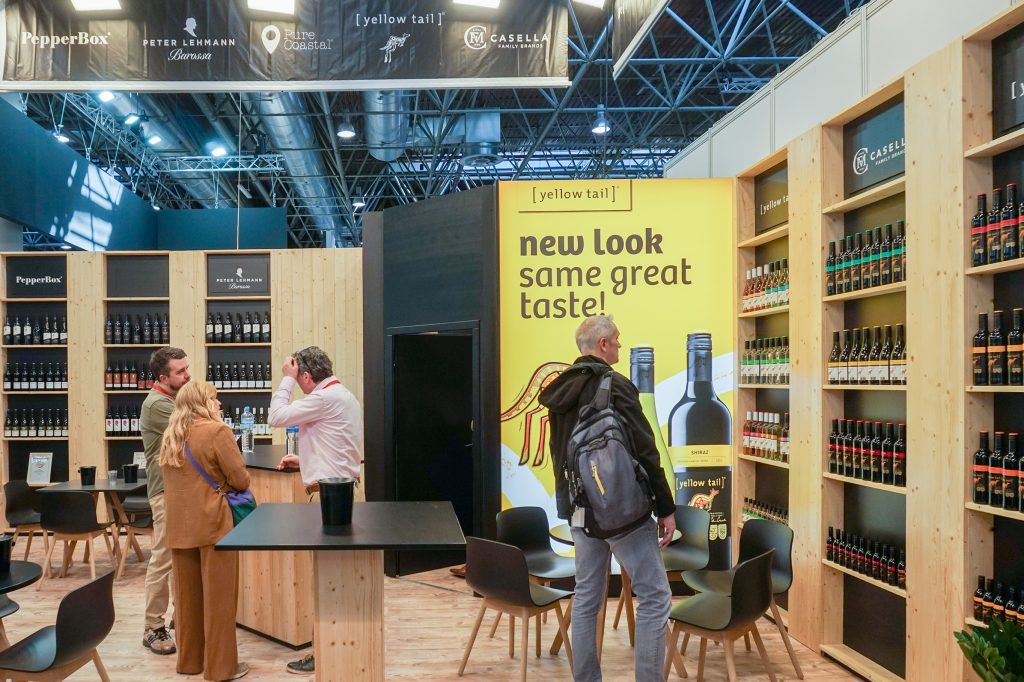
Brand building
Ultimately, the goal of a trade fair such as ProWein cannot be solely reduced to immediate conversions of foot traffic into sales. Instilling and upholding positive brand reputation was of utmost importance to both Australian and New Zealand producers present, particularly in an environment which allowed them to be compared to Old World or fast-emerging competitors, and not risk losing market share. A trade fair is an opportunity for a brand to put its best foot forward, whether that be the brand of an individual producer or that of a nation.
“It’s about the focus,” Moularadellis explained. “The London Wine trade fair 20 years ago had a transition period, and there was a movement of buyers and focus from London to Düsseldorf, and now we’re seeing a movement from Düsseldorf to Paris. But I think it’s important for us to have a presence at all three: both London, for Australia Day tastings, for Paris and for this fair, which is still the most important fair,” he said.
“We certainly will be back next year, there’s no question about that.”
Meg Riley travelled to ProWein Düsseldorf courtesy of Messe Düsseldorf
This article was originally published in the May 2025 issue of the Australian & New Zealand Grapegrower & Winemaker. To find out more about our monthly magazine, or to subscribe, click here!
Are you a Daily Wine News subscriber? If not, click here to join our mailing list. It’s free!
Note from editor: After the publication of this article, Wine Australia reached out to clarify the reasoning behind its decision-making process for ProWein Düsseldorf 2025:
“The decision not to participate in ProWein in 2025 was made only after extensive efforts to recruit a viable contingent of exhibitors,” said Wine Australia.
“As with all Wine Australia-led international market development initiatives, participation in major trade events is contingent on achieving minimum winery representation to ensure value and impact for exhibitors.
“Wine Australia remains committed to supporting wine exporters and continues to work closely with wine businesses across Australia to explore and deliver effective market development opportunities. Any questions about market development opportunities or tradeshow participation can be directed to [email protected].”
